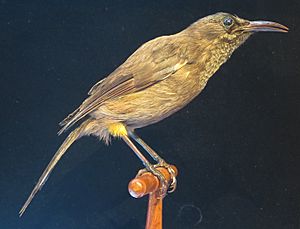Kauaʻi ʻōʻō facts for kids
Quick facts for kids Kauaʻi ʻōʻō |
|
|---|---|
 |
|
| The last Kauaʻi ʻōʻō was male, and his song was recorded for the Cornell Lab of Ornithology. The male was recorded singing a mating call, to a female that would never come. He died in 1987. | |
| Conservation status | |
| Scientific classification | |
| Genus: |
Moho
|
| Species: |
braccatus
|
| Synonyms | |
|
|
The Kauaʻi ʻōʻō (pronounced 'koh-WAH-ee oh-OH') was a special bird from the Hawaiian island of Kauaʻi. It was also known as the ʻōʻōʻāʻā (oh-OH-ah-AH). This bird belonged to a group called the ʻōʻōs, all of which are now extinct. It lived only on Kauaʻi, meaning it was endemic to that island.
Once, these birds were common in the island's warm, wet forests. But in the early 1900s, their numbers started to drop. The last time anyone heard its song was in 1987. Sadly, the Kauaʻi ʻōʻō is now extinct. Some reasons for its disappearance include new animals like rats and pigs, and diseases carried by mosquitoes. Losing their forest homes also played a big part.
Contents
What's in a Name?
The native Hawaiians gave this bird its name, ʻōʻō ʻāʻā. The word ʻōʻō sounds like the bird's call. This is called an onomatopoeia. The word ʻāʻā means 'dwarf' or 'small'. So, its name means 'small ʻōʻō' because it was one of the smallest of its kind.
What Did the Kauaʻi ʻōʻō Look Like?
This bird was one of the smallest ʻōʻōs. It was only about 20 centimetres (7.9 in) long. Its head, wings, and tail were black. The rest of its upper body was a dark brown color. Its lower back and sides were a reddish-brown.
The bird's throat and chest were black with white stripes. These stripes were easier to see on female birds. It had long feathers in the middle of its tail. There was also a small bunch of gray feathers under its wings. Its beak and legs were black, but the feathers on its legs were a bright golden yellow.
The Kauaʻi ʻōʻō was the only ʻōʻō with yellow eyes. Like other honeyeater birds, it had a sharp, slightly curved beak. This beak was perfect for sipping nectar from flowers. It loved nectar from Lobelia plants and the ʻohiʻa lehua tree. It also ate small invertebrates (like insects) and fruit.
These birds were very noisy. They made hollow, flute-like calls that sounded a bit messy. Both male and female birds would sing.
Why Did the Kauaʻi ʻōʻō Become Extinct?
The Kauaʻi ʻōʻō built its nests inside holes in old trees. These nests were found in the thick forests of Kauaʻi's canyons. Many of its relatives, like the Hawaiʻi ʻōʻō, Bishop's ʻōʻō, and Oʻahu ʻōʻō, have also disappeared. We don't know much about these other extinct birds.
The Kauaʻi ʻōʻō likely went extinct due to many problems. One big issue was diseases carried by mosquitoes. These diseases forced the birds to move to higher, cooler parts of the mountains. But in these higher forests, there weren't many old trees with holes for nesting. This meant fewer places for them to build nests and raise their young.
In the 1970s, a wildlife biologist named John L. Sincock filmed the only known video of this bird. Several recordings of its song were also made.
The final blow came from two strong hurricanes that hit Kauaʻi within ten years. These storms destroyed many of the old trees that the birds used for nesting. The second hurricane also stopped new trees from growing. This loss of their forest homes made it impossible for the birds to survive.
The last time anyone saw a Kauaʻi ʻōʻō was in 1985. The very last sound recording of its song was made in 1987 by David Boynton. Some people still hope that the bird might be alive somewhere, hidden away. This is because the species was thought to be extinct twice before, but then rediscovered. However, the Kauaʻi ʻōʻō had a loud, unique call. Even with many searches, no one has heard or seen one since 1987.
See also
 In Spanish: Moho braccatus para niños
In Spanish: Moho braccatus para niños




